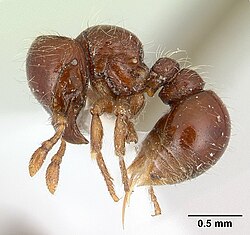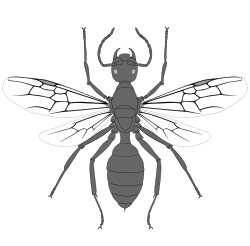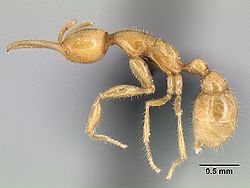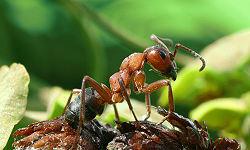| Formicidae |
|---|
| Subfamily [2] | Extant
genera [2] | Fossil
genera [2] | Type genus [2] | Comments | Example |
|---|
Agroecomyrmecinae
Carpenter, 1930 | 2 | 2 | † Agroecomyrmex
Wheeler, 1910 | Agroecomyrmecines were probably widespread in both hemispheres during the early Tertiary, but are today represented by only two species in two genera, Tatuidris and Ankylomyrma . The two fossil genera, Agroecomyrmex and Eulithomyrmex , are known from Eocene fossils. [11] [12] | 
Tatuidris tatusia |
Amblyoponinae
Forel, 1893 | 13 | 1 | Amblyopone
Erichson, 1842 | Specialized predators found worldwide, but mainly distributed in the tropics. [13] [14] | 
Apomyrma stygia |
Aneuretinae
Emery, 1913 | 1 | 8 | Aneuretus
Emery, 1893 | In addition to 8 fossil genera, the subfamily is represented by one extant genus, Aneuretus. The living genus has a single species, the Sri Lankan relict ant (Aneuretus simoni), endemic to Sri Lanka and only found in a few locations. The species is listed as critically endangered by the IUCN. [15] [16] | 
Aneuretus simoni |
Apomyrminae
Dlussky & Fedoseeva, 1988 | 1 | 1 | Apomyrma
Brown, Gotwald & Lévieux, 1970 | Contains a single described species, the rare subterranean ant Apomyrma stygia , and several undescribed species, all known from the Afrotropics. [17] | 
Apomyrma stygia |
†Armaniinae
Dlussky, 1983 | 0 | 8 | † Armania
Dlussky, 1983 | Known from Cretaceous fossils, this subfamily is sometimes treated as the family Armaniidae within the superfamily Formicoidea. They seem to lack a metapleural gland, which would exclude them from Formicidae given an apomorphy-based definition requiring such a gland to have evolved. However, the apparent lack of this gland in Armaniinae fossils could be due to poorer preservation. [1] [18] | 
Orapia rayneri |
†Brownimeciinae
Bolton, 2003 | 0 | 1 | † Brownimecia
Grimaldi, Agosti & Carpenter, 1997 | Contains the single species Brownimecia clavata , a fossil ant known from New Jersey amber. Initially placed within Ponerinae, this primitive Cretaceous ant was later moved to its own subfamily. [1] [18] | 
Brownimecia clavata |
Dolichoderinae
Forel, 1878 | 28 | 20 | Dolichoderus
Lund, 1831 | A diverse subfamily distributed worldwide, mainly in the tropics. Most species are generalized scavengers, but some are predacious. They lack a sting and instead rely on chemical defensive compounds produced from the anal gland. [19] [20] | 
Dolichoderus mariae |
Dorylinae
Leach, 1815 | 28 | 1 [a] [b] | Dorylus
Fabricius, 1793 | Contains the previous dorylomorph subfamilies (Aenictinae, Aenictogitoninae, Cerapachyinae, Ecitoninae and Leptanilloidinae), including the Old World and New World army ants. [3] | 
Dorylus helvolus |
Ectatomminae
Emery, 1895 | 4 | 3 | Ectatomma
Smith, 1858 | Found in tropical and warm climates in the New World, Old World and Indo-Australian regions. [20] | 
Ectatomma ruidum |
†Formiciinae
Lutz, 1986 | 0 | 1 [c] | † Formicium [d]
Westwood, 1854 | Known from Eocene fossils found in Europe and North America, this subfamily contains the genus Titanomyrma and the collective group name Formicium. [24] | 
Titanomyrma giganteum |
Formicinae
Latreille, 1809 | 51 | 30 | Formica
Linnaeus, 1758 | Worldwide in distribution, Formicinae is the second largest subfamily; only Myrmicinae is larger. [20] | 
Formica rufa |
Heteroponerinae
Bolton, 2003 | 3 | 0 | Heteroponera
Mayr, 1887 | Contains the two Neotropical genera, Acanthoponera and Heteroponera , and the genus Aulacopone, which is known from the single species, Aulacopone relicta , from Azerbaijan. [25] | 
Heteroponera brounii |
Leptanillinae
Emery, 1910 | 8 | 0 | Leptanilla
Emery, 1870 | Small subterranean ants known from Africa, Europe, Asia and a single species from Australia; no species are known from North or South America. Little is known about the biology of these ants. [26] [27] | 
Leptanilla swani |
Martialinae
Rabeling & Verhaagh, 2008 | 1 | 0 | Martialis
Rabeling & Verhaagh, 2008 | The subfamily is only known from a single specimen of the species Martialis heureka , collected in 2003 in the Amazon rainforest. Workers are pale and blind; queens and males are unknown. [28] | 
Martialis heureka |
Myrmeciinae
Emery, 1877 | 2 | 5 [e] | Myrmecia
Fabricius, 1804 | A formerly widespread subfamily, now only found in the Australasian region distributed in two extant genera. The genus Myrmecia , or "bulldog ants", is known from Australia, New Zealand and New Caledonia, and Nothomyrmecia, with the single species Nothomyrmecia macrops , is known from Australia. [30] | 
Myrmecia gulosa |
Myrmicinae
Lepeletier de Saint-Fargeau, 1835 | 140 | 35 | Myrmica
Latreille, 1804 | The largest subfamily of ants, distributed worldwide. Contains the seed-harvesting ants and fungus-growing ants. [20] | 
Myrmica lonae |
Paraponerinae
Emery, 1901 | 1 | 0 | Paraponera
Smith, 1858 | Contains the single genus Paraponera consisting of two species: the extant Paraponera clavata , also known as a bullet ant, found in the Neotropics, and the very small fossil species Paraponera dieteri known from Dominican amber (Early Miocene). [31] [32] | 
Paraponera clavata |
Ponerinae
Lepeletier de Saint-Fargeau, 1835 | 47 | 12 | Ponera
Latreille, 1804 | Predominantly predacious ants distributed in the tropics and subtropics. The subfamily formerly contained all the poneromorph subfamilies (at the time classified as tribes), which have now been divided into six subfamilies: Amblyoponinae, Ectatomminae, Heteroponerinae, Paraponerinae, Ponerinae and Proceratiinae. [20] [33] | 
Ponera coarctata |
Proceratiinae
Emery, 1895 | 3 | 1 | Proceratium
Roger, 1863 | Ants in this subfamily are small to medium in size. Found worldwide, although mainly tropical and subtropical in distribution. Little is known about their biology, but they are thought to be specialized predators. [20] [34] | 
Proceratium google |
Pseudomyrmecinae
Smith, 1952 | 3 | 0 | Pseudomyrmex
Lund, 1831 | A small subfamily consisting of three genera of predominantly arboreal ants found in tropical and subtropical regions. The ants, agile and with large eyes, are characterized by their slender bodies. [35] | 
Pseudomyrmex pallidus |
†Sphecomyrminae
Wilson & Brown, 1967 | 0 | 9 | † Sphecomyrma
Wilson & Brown, 1967 | Fossil subfamily of stem ants. Most Cretaceous ants are placed in this subfamily. [1] [36] | 
Sphecomyrma freyi |




















